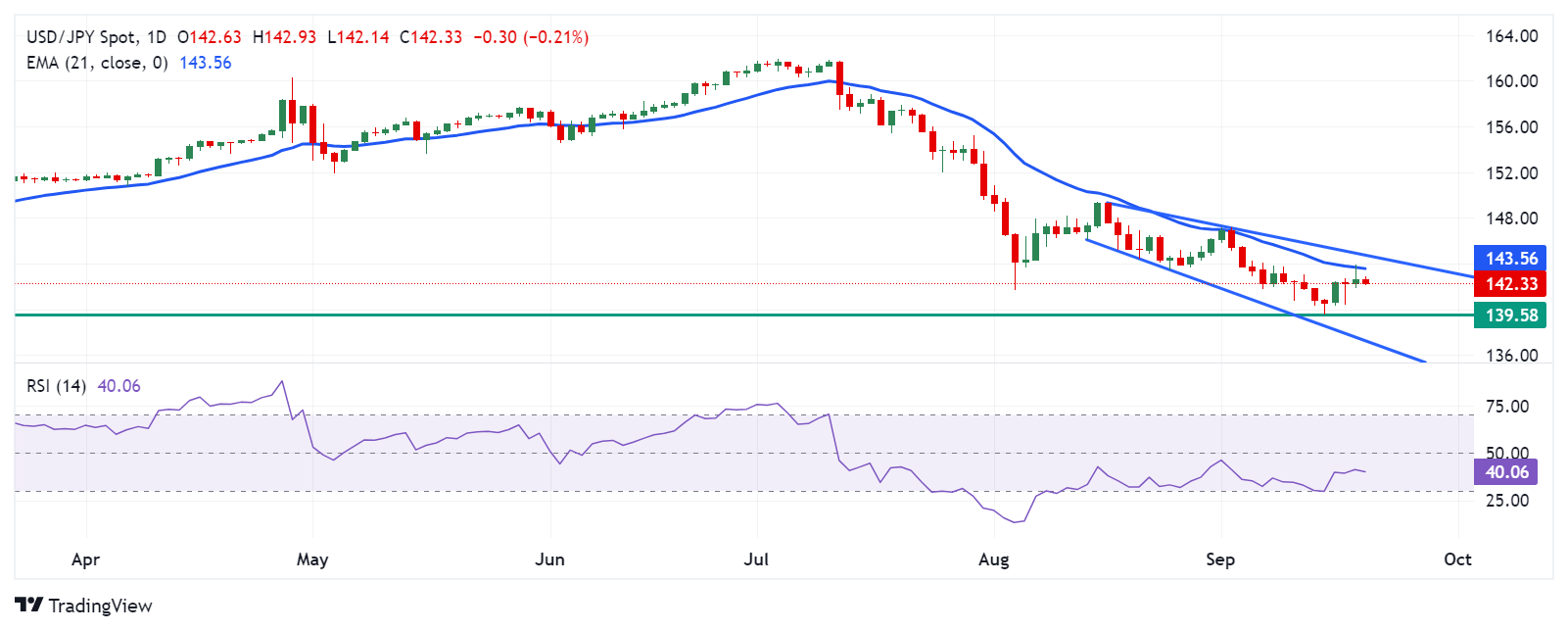- The Japanese Yen pares intraday gains following BoJ Governor Ueda's comments.
- BoJ Governor Ueda stated that the central bank will continue to adjust the level of monetary easing as needed.
- The US Dollar faces challenges due to rising odds for additional Fed rate cuts in 2024.
The Japanese Yen (JPY) trims its daily gains following the post-meeting comments from Bank of Japan (BoJ) Governor Kazuo Ueda. However, the JPY edges higher against the US Dollar (USD) following the Bank of Japan (BoJ) policy decision on Friday, keeping its interest rate target in the range of 0.15%-0.25%, as highly expected.
Additionally, Japan's Consumer Price Index (CPI) increased to 3.0% year-on-year in August, up from 2.8% previously, marking the highest level since October 2023. Additionally, the Core National CPI, excluding fresh food, reached a six-month high of 2.8%, rising for the fourth consecutive month and in line with market expectations.
BoJ Governor Ueda stated that the central bank "will continue to adjust the level of monetary easing as needed to achieve our economic and inflation targets." Ueda noted that while Japan’s economy is recovering moderately, some signs of weakness remain. He emphasized the need to closely monitor financial and foreign exchange markets, as well as their impact on Japan’s economy and prices.
The downside of the USD/JPY pair is supported by a weaker US Dollar (USD) as expectations grow for additional rate cuts by the US Federal Reserve (Fed) by the end of 2024. The latest dot plot projections indicate a gradual easing cycle, with the 2024 median rate revised to 4.375%, down from the 5.125% forecast in June.
However, Federal Reserve Chair Jerome Powell stated in the post-meeting press conference that the Fed is not in a hurry to ease policy and emphasized that half-percentage point rate cuts are not the "new pace."
Daily Digest Market Movers: Japanese Yen receives support from the hawkish BoJ policy outlook
- Japan’s Finance Minister Shunichi Suzuki stated on Friday that he “will continue to monitor and analyze the impact of the latest US rate cut on the Japanese economy and financial markets.” Suzuki added that the Federal Reserve Bank’s (FRB) perspective on the US economy aligns with the Japanese government's view that the US economy is likely to expand.
- US Treasury Secretary Janet Yellen stated on Friday that the recent interest rate cut by the Federal Reserve is a very positive indicator for the US economy. According to Yellen, it demonstrates the Fed's confidence that inflation has significantly decreased and is moving toward the 2% target. Meanwhile, the job market continues to show strength.
- The Federal Open Market Committee (FOMC) lowered the federal funds rate to a range of 4.75% to 5.0%, marking the Fed’s first rate cut in over four years. Fed policymakers updated their quarterly economic forecasts, increasing the median projection for unemployment to 4.4% by the end of 2024, up from the 4.0% estimate made in June. They also raised their long-term forecast for the federal funds rate from 2.8% to 2.9%.
- Federal Reserve Chair Jerome Powell commented on the aggressive 50 basis point rate cut, saying, “This decision reflects our increased confidence that, with the right adjustments to our policy approach, we can maintain a strong labor market, achieve moderate economic growth, and bring inflation down to a sustainable 2% level.”
- Japan’s Merchandise Trade Balance Total recorded a larger trade deficit of ¥695.30 billion in August, up from ¥628.70 billion the previous month, but well below market expectations of a ¥1,380.0 billion shortfall. Exports increased by 5.6% year-over-year, marking the ninth consecutive month of growth, but fell short of the anticipated 10.0%. Imports rose by just 2.3%, the slowest pace in five months, significantly underperforming the projected 13.4% rise.
- Japanese Finance Minister Shunichi Suzuki stated on Tuesday that rapid foreign exchange (FX) fluctuations are undesirable. Suzuki emphasized that officials will closely monitor how FX movements affect the Japanese economy and people's livelihoods. The government will continue to assess the impact of a stronger Japanese Yen and respond accordingly, according to Reuters.
- Commerzbank FX analyst Volkmar Baur anticipated that the Bank of Japan will remain on the sidelines this week. Baur noted that the Federal Reserve's actions are likely to have a greater impact on the USD/JPY pair, suggesting that the JPY could have a strong chance of falling below 140.00 per USD even without a rate hike from the BoJ.
Technical Analysis: USD/JPY falls toward 142.00; further downside guided by 21-day EMA
USD/JPY trades around 142.30 on Friday. Analysis of the daily chart indicates that the pair is consolidating within a descending channel, which supports a bearish bias. However, the 14-day Relative Strength Index (RSI) remains below the 50 level, confirming an ongoing bearish outlook.
On the downside, the USD/JPY pair might find immediate support at 139.58, which is the lowest level since June 2023, followed by the lower boundary of the descending channel near 137.50.
On the resistance side, the 21-day Exponential Moving Average (EMA) at the 143.56 level acts as an initial barrier, followed by the upper boundary of the descending channel around the 144.80 level.
USD/JPY: Daily Chart
Japanese Yen PRICE Today
The table below shows the percentage change of Japanese Yen (JPY) against listed major currencies today. Japanese Yen was the strongest against the Australian Dollar.
| USD | EUR | GBP | JPY | CAD | AUD | NZD | CHF | |
|---|---|---|---|---|---|---|---|---|
| USD | -0.01% | -0.04% | -0.21% | 0.03% | 0.06% | 0.03% | -0.13% | |
| EUR | 0.00% | -0.04% | -0.19% | 0.02% | 0.05% | 0.05% | -0.12% | |
| GBP | 0.04% | 0.04% | -0.13% | 0.09% | 0.12% | 0.09% | -0.06% | |
| JPY | 0.21% | 0.19% | 0.13% | 0.24% | 0.25% | 0.22% | 0.09% | |
| CAD | -0.03% | -0.02% | -0.09% | -0.24% | 0.00% | 0.00% | -0.15% | |
| AUD | -0.06% | -0.05% | -0.12% | -0.25% | -0.01% | 0.00% | -0.15% | |
| NZD | -0.03% | -0.05% | -0.09% | -0.22% | -0.00% | -0.00% | -0.15% | |
| CHF | 0.13% | 0.12% | 0.06% | -0.09% | 0.15% | 0.15% | 0.15% |
The heat map shows percentage changes of major currencies against each other. The base currency is picked from the left column, while the quote currency is picked from the top row. For example, if you pick the Japanese Yen from the left column and move along the horizontal line to the US Dollar, the percentage change displayed in the box will represent JPY (base)/USD (quote).
Interest rates FAQs
Interest rates are charged by financial institutions on loans to borrowers and are paid as interest to savers and depositors. They are influenced by base lending rates, which are set by central banks in response to changes in the economy. Central banks normally have a mandate to ensure price stability, which in most cases means targeting a core inflation rate of around 2%. If inflation falls below target the central bank may cut base lending rates, with a view to stimulating lending and boosting the economy. If inflation rises substantially above 2% it normally results in the central bank raising base lending rates in an attempt to lower inflation.
Higher interest rates generally help strengthen a country’s currency as they make it a more attractive place for global investors to park their money.
Higher interest rates overall weigh on the price of Gold because they increase the opportunity cost of holding Gold instead of investing in an interest-bearing asset or placing cash in the bank. If interest rates are high that usually pushes up the price of the US Dollar (USD), and since Gold is priced in Dollars, this has the effect of lowering the price of Gold.
The Fed funds rate is the overnight rate at which US banks lend to each other. It is the oft-quoted headline rate set by the Federal Reserve at its FOMC meetings. It is set as a range, for example 4.75%-5.00%, though the upper limit (in that case 5.00%) is the quoted figure. Market expectations for future Fed funds rate are tracked by the CME FedWatch tool, which shapes how many financial markets behave in anticipation of future Federal Reserve monetary policy decisions.
Information on these pages contains forward-looking statements that involve risks and uncertainties. Markets and instruments profiled on this page are for informational purposes only and should not in any way come across as a recommendation to buy or sell in these assets. You should do your own thorough research before making any investment decisions. FXStreet does not in any way guarantee that this information is free from mistakes, errors, or material misstatements. It also does not guarantee that this information is of a timely nature. Investing in Open Markets involves a great deal of risk, including the loss of all or a portion of your investment, as well as emotional distress. All risks, losses and costs associated with investing, including total loss of principal, are your responsibility. The views and opinions expressed in this article are those of the authors and do not necessarily reflect the official policy or position of FXStreet nor its advertisers. The author will not be held responsible for information that is found at the end of links posted on this page.
If not otherwise explicitly mentioned in the body of the article, at the time of writing, the author has no position in any stock mentioned in this article and no business relationship with any company mentioned. The author has not received compensation for writing this article, other than from FXStreet.
FXStreet and the author do not provide personalized recommendations. The author makes no representations as to the accuracy, completeness, or suitability of this information. FXStreet and the author will not be liable for any errors, omissions or any losses, injuries or damages arising from this information and its display or use. Errors and omissions excepted.
The author and FXStreet are not registered investment advisors and nothing in this article is intended to be investment advice.
Recommended content
Editors’ Picks

EUR/USD holds gains below 1.1000 ahead of US CPI release
EUR/USD is tirmimng gains while below 1.1000 in the European session on Thursday. The Euro gains on the German coalition deal and Trump's 90-day pause on reciprocal tariffs. Meanwhile, the US Dollar finds demand on profit-booknig ahead of the US CPI data release.

GBP/USD trades firm above 1.2850, US CPI data awaited
GBP/USD sustained the rebound above 1.2850 in European trading hours on Thursday. The British Pound capitalizes on risk appetite, courtesy of Trump's tariff pause, allowing the pair to recover ground. But further upside hinges on the US CPI data and US-Sino trade updates.

Gold price eases from weekly top amid risk-on mood; still well bid above $3,100 ahead of US CPI
Gold price trims a part of its strong intraday gains to a one-week high touched during the early European session on Thursday and currently trades just above the $3,100 mark. Concerns about escalating US-China trade tensions, along with fears about a tariffs-driven economic slowdown, turn out to be key factors that continue to underpin the safe-haven bullion.

XRP back above $2 liquidating $18M in short positions, will the rally continue?
Ripple seeks support above $2.0020 on Thursday after gaining 14% in the past 24 hours. The token trades at $2.0007 at the time of writing, reflecting growing bullish sentiment across global markets.

Tariff rollercoaster continues as China slapped with 104% levies
The reaction in currencies has not been as predictable. The clear winners so far remain the safe-haven Japanese yen and Swiss franc, no surprises there, while the euro has also emerged as a quasi-safe-haven given its high liquid status.

The Best brokers to trade EUR/USD
SPONSORED Discover the top brokers for trading EUR/USD in 2025. Our list features brokers with competitive spreads, fast execution, and powerful platforms. Whether you're a beginner or an expert, find the right partner to navigate the dynamic Forex market.




